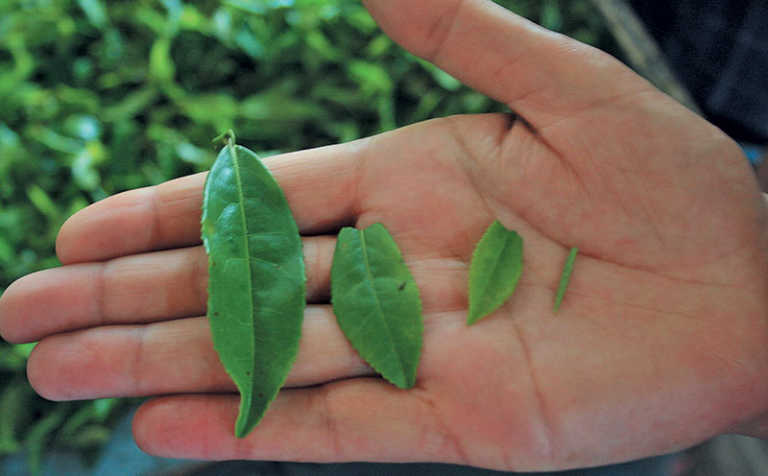
Photo: Arne Hückelheim
Tea comes in four types: black, oolong, green and white. All are made from leaves of the shrub Camellia sinensis, an evergreen plant of mainly tropical and subtropical climates. Cultivated plants are usually pruned to waist height for easier plucking on the plantations.
Black tea tends to have a stronger flavour than the other types. It retains its flavour for several years and has a longer shelf life. For this reason, it is the world’s most popular and traded variety.
In South Africa, black tea is grown in Limpopo (Vhembe region), Kwazulu-Natal (Nkandla), the Eastern Cape (Lusikisiki) and Mpumalanga (Noordkaap River).
Tea is broadly divided into two varietal groups: Chinese teas (C. sinensis var sinensis) and Indian teas (C. sinensis var assamica).
Chinese tea
The Chinese tea plant is a hardy bush that can survive colder temperatures and drought. It is long-living and productive, with some cultivars producing tea for a century or longer. If left to grow on its own, it can attain a height of 6m. It has relatively small and narrow leaves, which are used to produce green tea and Chinese black tea.
Indian tea
The Assam tea tree is less hardy than the Chinese type. It cannot survive frost and drought, but thrives in heavy rain. Its larger, rather droopy, leathery leaves are used to make Indian black tea.
Overall botanical description
- Leaves: Dark green with a toothed margin. Between 5cm and 10cm long and 2cm to 5cm wide, depending on the variety. Young leaves are hairy; older leaves become glabrous (hairless). Glands in the leaf contain an essential oil that gives the tea its flavour.
- Flowers: Generally white with a yellow centre, and 2,4cm to 4cm in diameter, with seven or eight petals.
- Stem: Strong, thick and yellow. It can be solitary or two or three can occur together on short branchlets in the leaf axils.
- Roots: A tea plant grown from a seedling has a strong taproot with a dense network of feeder roots, mostly in the uppermost 30cm of soil. The taproot reaches a depth of between 1,5m and 3m.
- Fruits: This is 2cm to 3cm in diameter and brownish-green when mature. It contains one to four spherical or flattened brown seeds. The fruit ripens in nine to 12 months, after which the seeds fall to the ground.
Climatic requirements
Temperature: This plays a crucial part in the growth and yield of tea. The ideal mean annual temperature is between 18°C and 20°C, with at least five hours’ sunlight a day. Relative humidity should be 80% to 90% during the growth period. If it is below 50%, shoot growth is inhibited; if it is below 40%, growth is affected.
Water:Tea plants grow well on hillsides where the annual rainfall varies between 1 150mm and 6 000mm. Regular watering is essential as the roots become established; twice a week is usually sufficient.
Soil:Tea grows best in fertile, well-drained, sandy mountain soil that is slightly acidic (pH 4,5 to 5,5). The soil should be at least 2m deep, be rich in minerals, and have a well-developed humus-containing horizon.
Dystrophic (highly leached) soils, which commonly occur in valleys and areas with a rainfall in excess of 1 000mm/year, are also suitable. Good internal drainage is essential in this case.
The best soil for tea, however, is a light, friable loam with porous subsoil, which permits a free percolation of water. The tea plant does not tolerate stagnant water.
Source: Black tea production guidelines, Directorate Plant Production, Department of Agriculture, Forestries and Fisheries.













